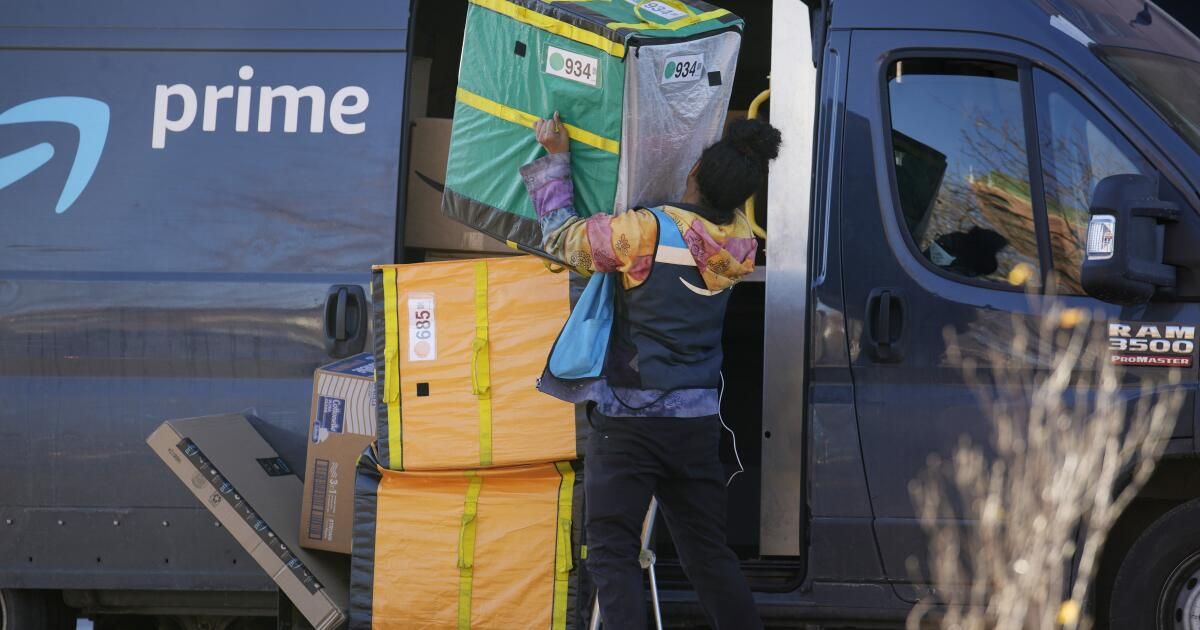While Amazon's plastic packaging is labeled as recyclable, most end up in landfills, according to a new report.
(David Zalubowski / Associated Press)
Although plastic packaging delivered by Amazon is marked with recycling arrows, a new report suggests that only a fraction of it is recycled.
The report from the US Public Interest Research Group comes at a time of growing public awareness about single-use plastic waste, even as e-commerce companies continue to lure consumers with the promise of quick and easy purchases. easy. Meanwhile, researchers warn that micro- and macroplastics are increasingly appearing in human tissues, dust, water, alpine snow and even clouds.
Estimates from PIRG and others, including Oceana, suggest that in 2021, 3.4 billion pounds of plastic waste was generated globally from e-commerce. Of that total, Amazon contributed approximately 709 million pounds (enough to circle the Earth more than 800 times) in the form of air pillow packaging.
Worse yet, those numbers are expected to double by 2026, according to Jenn Engstrom, the report's author and director of CalPIRG.
Although the paper and cardboard items that Amazon uses for packaging can be placed in curbside bins and are generally recycled, plastic packaging (air pillows, bubble wrap, plastic film) must be taken to recycling locations. delivery, like those at Safeway or Target stores. , where it is sent to its final destination.
The package indicates the store delivery requirement within printed recycling arrows and often includes instructions such as “remove paper label before recycling.”
However, the question remains how many consumers take their plastic waste to drop-off locations or take the time to remove “contaminants” such as paper labels, tape and glue that can prevent the item from being recycled.
To evaluate the success of the drop-for-recycle scenario, Engstrom, her colleagues and volunteers across the country attached Apple trackers to 93 plastic items.
They found that most waste was not being recycled (perhaps not surprising, as people who order online seek the convenience of having items delivered to their homes rather than venturing out).
Only four of 93 plastic containers were confirmed to have ended up at a materials recovery center that sorts plastic for recycling. Thirteen were transported by truck to landfills. Two were tracked to an incinerator to be burned and three went to the port of Los Angeles, presumably bound for overseas locations such as Malaysia or Vietnam. The rest of the tracking devices were lost or died along the way.
About a quarter ended up at a company called Trex, based in Nevada and Virginia, which uses plastic film to create decks. The company grinds plastic film into granules and then mixes it with sawdust to create composite boards.
Engstrom said it's unclear how much of the consumer packaging Trex actually uses. According to his report and company guidelines, plastic film should be “free from food or liquid contamination” and “labels should be removed if possible.”
Katie Larsen, an Amazon spokesperson, said in a statement that the company “is continually reducing packaging waste and working to make recycling easier for customers, however, we have no control over how packaging is handled once it has been disposed of.” by municipalities or recycling centers.”
He said the company has begun “a multi-year effort to transition U.S. fulfillment centers from plastic to paper for our delivery packaging.”
Jan Dell, director of Orange County-based Last Beach Cleanup and former member of the California State Curbside and Recycling Markets Commission, said the results were not surprising.
In 2021, Dell worked with Bloomberg Investigates to track Amazon's plastic bags, and “they went to landfill, incineration and export,” he said.
“These companies know that consumers are confused by recyclable labels and mistakenly place bags and films in trash bins,” he said. “They are ruining recycling through costly and dangerous pollution.”
Plastic films in containers destined for recycling centers are problematic for materials recovery facilities. The film can jam machinery (not only potentially destroying expensive technology but also endangering workers) or, due to its light weight, be sorted among waste paper and contaminate it, making it unsaleable.
“We can all exist with much less plastic in our lives,” said Robert Reed, spokesman for Recology, a California materials recovery company.
Newsletter
Towards a more sustainable California
Get Boiling Point, our newsletter exploring climate change, energy and the environment, and be part of the conversation and the solution.
You may occasionally receive promotional content from the Los Angeles Times.












